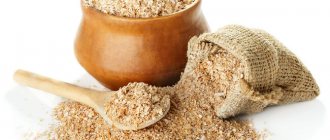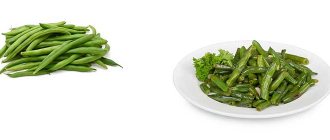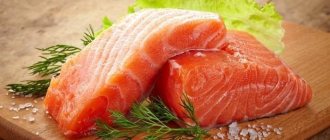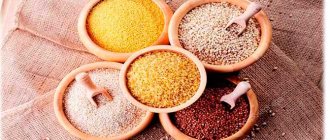Flounder is not as popular as some other types of fish. Some people are put off by its bright aroma, some don’t like its appearance, some believe that they won’t be able to clean and cook it properly.
It is sad. For people who refuse flounder deprive themselves of its benefits. And they do it in vain. Since cleaning and preparing fish is very simple, and you can get rid of the specific smell with the help of lemon.
general characteristics
Flounder is a resident of salt waters and estuaries. It is impossible not to recognize her. Its flattened, asymmetrical carcass is only 32-35 cm in length, but can weigh about 6 kg. Although at the end of the twentieth century in Alaska, fishermen caught a 2-meter giant flounder weighing 105 kg. Flounder differs from other fish in the placement of its eyes - both are on the right side of the carcass. But it is worth noting that these fish are born, so to speak, normal - outwardly they practically do not differ from other fish. But over time, their body becomes deformed, and their eyes “slide” to one side.
Content:
- general characteristics
- Nutritional characteristics
- Useful properties of flounder
- How to choose and cook correctly
- Hazardous properties
The body is unusually colored - different colors on both sides. The upper part of the flounder (where the eyes are) is dark brown, the bottom (the side without eyes) is white. Flounder loves muddy water and sandy bottoms, where they spend most of their lives. She lies on the sand and in this position moves along the seabed. Its peak activity occurs at night. During the day, she prefers to sleep peacefully, buried in the sand. Flounder feeds on insects, eggs of other fish, small crustaceans and mollusks. But with the onset of winter, it almost completely abandons food and migrates to deeper and saltier waters. Her native and favorite places are the coasts of Europe, the White, Okhotsk, Barents, Black and Baltic seas. This fish is found in the Mediterranean and Atlantic Ocean. Sea flounder is a very prolific fish. During the spring spawning period, she can lay 10 million eggs.
Flounder on onion bed
- flounder fillet – 0.5 kg;
- onions – 0.3 kg;
- lemon – 0.5 pcs.;
- olive oil – 40 ml;
- parsley – 50 g;
- salt, spices - to taste.
- Wash the flounder fillet and pat dry with a napkin. Separate from the skin and cut into portions.
- Wash the lemon, cut in half, squeeze out the juice.
- Rub each piece with salt and spices, sprinkle with lemon juice. You don't need to use about half of the juice yet.
- Leave the flounder for half an hour to marinate.
- Peel the onion and cut into half rings. Pour boiling water, after a minute drain the water, squeeze the onion.
- Place foil on the bottom of the fireproof pan. Grease it well with olive oil. Place onion on foil.
- Chop the parsley and sprinkle on top of the onion. Sprinkle with the remaining oil and lemon juice, stirring first.
- Place the flounder pieces on the onion bed. Cover with foil.
- Place the fish in an oven preheated to 220 degrees. Bake it for 35 minutes. 20 minutes after the start of cooking, reduce the temperature in the oven to 180 degrees, and 10 minutes before cooking, remove the foil from the pan so that the fish is covered with an appetizing crust.
Serve the fish prepared according to this recipe with buckwheat, rice or a vegetable side dish. Be sure to place the onions on which it was baked on plates.
Nutritional characteristics
Flounder is a good source of those same polyunsaturated fatty acids, which is why nutritionists suggest we eat fish twice a week.
In addition to omega-3, flounder fillet also contains omega-6 fatty acids, also in proportions beneficial to the human body, as well as vitamins D, E and A. This moderately fatty fish (contains from 1 to 4 percent fat) belongs to dietary products: 100 g contains no more than 100 kcal. Nutritional value per 100 g
| Calorie content | 83 kcal |
| Squirrels | 16.5 g |
| Fats | 3 g |
| Cholesterol | 58 mg |
| Sodium | 92 mg |
| Potassium | 332 mg |
| Calcium | 27 mg |
| Phosphorus | 200 mg |
| Magnesium | 2.4 mg |
| Iron | 0.4 mg |
| Zinc | 0.5 mg |
| Copper | 0.05 mg |
| Manganese | 0.04 mg |
| Vitamin A | 9 IU |
| Vitamin E | 0.36 mg |
| Vitamin B1 | 0.22 mg |
| Vitamin B2 | 0.21 mg |
| Vitamin B3 | 3.4 mg |
Harm and contraindications
Flounder itself is not harmful; it is a healthy dietary product. Undesirable consequences arise when it is consumed by people who have certain diseases and do not take into account preparation methods that can provoke an exacerbation of the condition:
- If you have hypertension and kidney disease, you should not eat salted, dried and smoked flounder, because possible disturbance of the water-salt balance of the body, the formation of edema;
- People with gastrointestinal and liver problems should not eat fried flounder because it absorbs large amounts of fat and puts additional stress on these organs. As a result, pain in the liver and stool disturbances are possible:
- If you have an individual intolerance to seafood, an allergic reaction may occur:
- with a lack of enzymes that break down protein, exacerbation of liver and kidney diseases, bloating, and diarrhea are possible.
You should not eat flounder if you suspect that it is being sold without a quality certificate. Such fish can be caught in environmentally unfavorable regions and contaminated with salts of heavy metals and other harmful substances. Therefore, you need to buy it from reliable retailers.
Useful properties of flounder
The polyunsaturated fatty acids contained in fish fillets are important for reducing blood lipid levels, including cholesterol. They stabilize heart rate and blood pressure, and also prevent the formation of blood clots. Scientists have reason to believe that omega substances have anti-cancer properties - they suppress the growth of cancer cells and prevent the proliferation of tumors. For this reason, flounder and some other types of fish are considered a food that can prevent prostate, breast, lung and colon cancer. Regular consumption of flounder meat will minimize allergies and also significantly improve the functioning of the nervous system and liver. This product has anti-inflammatory and restorative properties.
Flounder is a recommended product in the diet of pregnant women. The special chemical composition of fish dishes has a beneficial effect not only on the pregnant body, but also on the fetus, mainly in terms of the formation of the nervous system and brain of the unborn child.
Flounder dishes also have a positive effect on vision, preventing eye diseases. And this is the merit of omega-3 fatty acids and vitamin A. Flounder is useful for people engaged in mental work and students. The mineral and vitamin composition of fish has a beneficial effect on brain performance, enhances memory and cognitive abilities. By influencing human brain cells, this fish also prevents depression, calms and alleviates the effects of stressful situations.
Thanks to vitamin E, which is famous as the vitamin for eternal youth, flounder can prevent senile dementia and improve physical and mental health. For this reason, people over 60 years of age should regularly consume flounder and other fish containing vitamin E.
All sea fish, and flounder is no exception, are a good source of iodine, which is necessary for healthy thyroid function and increased performance. Another traditional plus of all fish, be it salmon, mackerel or anchovy, is the rich content of high-quality protein. Flounder meat is an almost complete set of amino acids important for humans. For this reason, the product is indispensable in the diet of people who want to restore physical strength, build muscle mass, as well as for children during the period of active development. Being a source of phosphorus, flounder is useful for strengthening bones and tooth enamel.
And some attribute aphrodisiac properties to flounder, calling it the fish of love.
Flounder as a dietary product
Flounder is an excellent source of protein and contains a huge amount of vitamins, iodine and other important substances that ensure the normal functioning of the body. Cholesterol in the blood does not increase when eating flounder meat, since the fish contains only 3% fat. Moreover, the excellent taste of fish, regardless of the cooking method, will delight any gourmet.
Eating flounder helps burn fat and maintain the body in the necessary tone for people on a diet. For athletes and people who work physically, eating flounder will provide a surge of energy and strength.
How to choose and cook correctly
Gourmets advise choosing large specimens - from 20 cm and more. A fresh carcass always has a pink gill, the flesh quickly regains its shape after pressing with a finger, and the fish itself should not smell bad.
Any fresh fish is a quickly perishable product. Raw flounder is stored in the refrigerator, covered with ice, for no more than two days. Deep freezing will preserve the carcass for another 4 months. Cooked fish should be eaten within 24 hours.
There are many ways to cook fish, and each of them is suitable for flounder. Its white meat is juicy and tender, but with a specific smell. But it’s enough to peel the skin off the carcass for it to disappear. The fish is cleaned first from the light side, then the head is cut off and the giblets are removed, after which the skin on the dark side is sharply removed. And now a little secret from the chefs: first, the flounder is fried on the dark side - this makes it tastier.
How to cut a carcass
Many fish lovers refuse to buy flounder because they do not know how to cut its flat carcass. And doing this is not as difficult as it might seem.
Before cutting, it is important to wash the fish thoroughly and place it on a board. Make an incision along the line of the spine. Make the second cut perpendicular to the first (to the belly). Make another cut along the fin line. Inserting a knife under the flesh and pressing it against the bones, cut off the first segment of meat. Place the resulting fillet on a cutting board, skin side down, and cut off the meat. Repeat similar steps with the remaining two pieces. Then turn the carcass over to the other side and do the same. Rinse the fillet again and you are ready to cook.
Flounder with tomatoes and spinach
In addition to several flounder carcasses, fresh spinach and tomatoes (canned), you will also need basil, garlic, ground pepper and olives. Add some chopped garlic and tomatoes to the heated oil. While they are simmering over low heat, make a paste from basil, olives and olive oil and rub it on each piece of flounder fillet. Then roll the fish into a roll and secure with a toothpick. Place the flounder in a baking dish and cover with tomato-garlic sauce. Bake at 180 degrees for about 15 minutes. Meanwhile, boil the spinach, which will serve as a side dish for the fish.
Greek flounder
Best materials of the month
- Coronaviruses: SARS-CoV-2 (COVID-19)
- Antibiotics for the prevention and treatment of COVID-19: how effective are they?
- The most common "office" diseases
- Does vodka kill coronavirus?
- How to stay alive on our roads?
Finely chop the garlic, cut the onion into rings and fry together in olive oil. Rub gutted, cleaned and filleted flounder with a mixture of black pepper and salt. Place one piece of fish in a baking dish, fried garlic and onion on top, then a layer of tomatoes and lemon rings. Cover with the second piece of fillet. Drizzle with olive oil and bake for half an hour.
How to cook flounder with sour cream and curry sauce?
- Wash the fish thoroughly. Trim the fins and remove the entrails.
- Cut into medium-sized pieces.
- Place the chopped fish in one layer in the dish in which the fish will be cooked.
- Place sour cream on the fish layer and season it with curry on top.
- Place on low heat and simmer for 20 minutes. Then turn it off and let it sit for a while.
- Will you follow the recipe? You will get a real culinary masterpiece! Bon appetit : )
Hazardous properties
Flounder can become dangerous only in exceptional cases. This applies to individuals caught in polluted waters. It is known that fish carcasses easily absorb all toxins from water, including dangerous mercury. People with fish allergies and protein intolerance should not eat flounder. If the fish is intended for a child, it is very important to ensure the freshness of the product and the quality of its preparation.
Flounder is an invaluable fish. Excellent taste and nutritional characteristics make it one of the most popular fish in the world. Its white meat remains juicy and tender in any dish.
More fresh and relevant information about health on our Telegram channel. Subscribe: https://t.me/foodandhealthru
We will be grateful if you use the buttons:
How to eat flounder: daily intake
Experts suggest familiarizing yourself with the daily intake of fish, which is indicated for an adult. It is equal to 100-250 g of flounder per day. This is the optimal portion that allows you to saturate the body with all nutrients and not cause harm to it.
Important! It is strictly forbidden to give flounder to children under 1 year of age.
Flounder should not be used as one of the ingredients in a raw dish. This increases the likelihood of human infection by parasites that may be contained in fish.
Whole flounder baked in the oven
- flounder (carcass without head) – 1.5 kg;
- butter – 50 g;
- vegetable oil – 20 ml;
- lemon – 1 pc.;
- parsley – 10–20 g;
- fresh dill – 10–20 g;
- salt, ground black pepper - to taste.
- Rinse the defrosted flounder under running water, cut off the fins, dry with paper towels and place on a plate or cutting board, yellowish side up. Make several cuts across at a distance of about 2-3 cm from each other.
- Rub the carcass on all sides with salt and pepper, sprinkle with juice squeezed from half a lemon. Leave for 20 minutes.
- Remove the butter from the refrigerator, measuring out the required amount. Leave in a warm place to soften.
- Cut the remaining half of the lemon into half slices, not too thin.
- Grease a baking sheet with vegetable oil. Place the flounder on it and place in the oven, preheated to 220 degrees, for 15 minutes.
- Remove the fish. Insert lemon slices into the slits. Return to oven for another 25 minutes.
- Finely chop the parsley and dill, mix them with butter.
- Grease the flounder with oil, remove the lemon slices, and leave in the switched off oven for another couple of minutes.
This is the easiest recipe for making baked flounder. Anyone can make a tasty and beautiful dish using it.
Optimal cooking methods
Tender and dense flounder meat can be prepared in a variety of ways. The best heat treatment options for the diet are baking, stewing, grilling or steaming. At the same time, you should not cook flounder in water - it will quickly lose its natural taste and become tougher.
Thanks to its special texture, the fish fillet cooks as quickly as possible: the meat will be ready in about 8 minutes on the grill, in 15 minutes in the oven. Rapid heat treatment allows you to preserve all the beneficial substances. Adding various spices and marinades to the fish, which are allowed on the diet, adds variety to the menu.










